Simplifying the Bail Process: Your Guide to Bail Bonds
Browsing the bond process can commonly feel frustrating, specifically for those unknown with the numerous types of bond bonds and the steps included in safeguarding release. As soon as detained, the succeeding bond hearing will establish the monetary commitments required for launch.
Comprehending Bail Fundamentals
While the lawful system can usually appear daunting, recognizing the basics of bail is important for browsing the complexities of pretrial release. Bond works as a monetary assurance that an offender will appear in court for their arranged hearings. When an individual is apprehended, a judge figures out the bail amount based upon numerous variables, including the nature of the criminal activity, the offender's criminal background, and the danger of trip.
Bail can take numerous forms, including money bond, where the offender pays the total upfront, or guaranty bonds, where a bond bondsman guarantees the bail for a fee. If the accused stops working to show up in court, they waive the bail quantity, which can cause added lawful effects.
In some situations, individuals may be launched by themselves recognizance, meaning they do not require to pay bond but should guarantee to return for their court dates. Understanding these fundamental principles is essential for defendants and their family members as they navigate the bail process, guaranteeing informed decisions are made throughout a difficult time.
How Bail Bonds Work
Understanding just how bail bonds job is critical for any individual included in the bond procedure. A bail bond is a lawfully binding agreement in between a bail bondsman, the offender, and the court.
The bondsman typically charges a non-refundable cost, usually around 10-15% of the complete bail quantity. This fee stands for the bail bondsman's settlement for assuming the monetary risk connected with the bond. When the cost is paid, the bondsman messages the complete bond total up to the court, protecting the offender's release from custody.
In exchange for this service, the bail bondsman may need security, such as home or properties, to mitigate possible losses if the accused fails to appear in court. If the accused does not participate in the scheduled hearings, the bondsman can recoup the bond quantity through legal ways, which might consist of working with a fugitive hunter. Comprehending this procedure can aid people navigate the intricacies of securing a bail bond successfully.
Kinds of Bond Bonds
After safeguarding a bail bond, it is necessary to recognize that not all bond bonds are the same; they come in different kinds made to suit various situations and needs. One of the most usual kind is the guaranty bond, which entails a bondsman who guarantees the full bail amount to the court in exchange for a charge, typically around 10% of the total bond. This is ideal for those that can not pay for to pay the complete bond amount upfront.
Another type is the cash bond, where the offender or their depictive pays the complete bond amount in cash straight to the court. This alternative is usually made use of when people have the monetary ways and prefer to recover their funds upon court appearance.
Property bonds permit individuals to use property as security for bond. bail bond company newark ohio. This find here requires a residential property evaluation and can be complex, yet it is helpful for those who possess beneficial possessions
Lastly, some jurisdictions provide individual recognizance bonds, where the accused is released based upon a guarantee to appear in court without any kind of monetary obligation. Recognizing these types of bond bonds is vital for making informed choices in your situation.
The Bond Process Steps
Browsing the bail procedure involves a number of vital steps that can dramatically affect the end result of a defendant's scenario. The procedure commonly begins with the apprehension, throughout which the individual is nabbed. Once jailed, the defendant will certainly be educated of the fees and might have a bond hearing scheduled, where a judge will certainly establish the bond amount based upon the seriousness of the criminal activity, flight danger, and criminal background.
After the bond quantity is set, the accused or their rep can contact a bond bondsman. The bondsman will assess the circumstance, clarifying the regards to the bond and the fees included, which typically total up to a percent of the complete bail. If an agreement is reached, the bondsman will certainly upload the bond with the court, enabling the accused to be launched from protection.

Tips for Selecting a Bail Agent
Selecting a bail representative websites is a critical action that can substantially affect the bond process. It is important to pick an agent who not just recognizes the lawful complexities yet additionally gives trusted assistance during this demanding time. Begin by researching licensed bond agents in your area; guarantee they have the necessary qualifications and experience in handling your particular situation.
Inspect evaluations and reviews from previous clients to determine the agent's credibility. A credible bond agent should show expertise, transparency, and compassion. Don't hesitate to ask concerns concerning their fees, processes, and any prospective security requirements. Comprehending the economic obligations ahead of time can help prevent unanticipated costs in the future.
Furthermore, take into consideration the availability and responsiveness of the bail agent. A good agent needs to come 24/7, prepared to supply help whenever needed. Review their interaction design; a representative that listens and describes clearly can make the procedure more manageable.

Final Thought
In final thought, navigating the bond procedure needs a clear understanding of the numerous types of bond bonds and the procedural actions involved. Engaging with a qualified bail bondsman is critical for facilitating launch while ensuring compliance Resources with court commitments.
Navigating the bail process can often really feel frustrating, particularly for those unknown with the numerous types of bond bonds and the steps entailed in safeguarding release.Comprehending just how bond bonds work is critical for anyone included in the bond procedure. A bail bond is a lawfully binding contract in between a bond bondsman, the defendant, and the court.After protecting a bail bond, it is crucial to identify that not all bail bonds are the exact same; they come in various kinds made to fit various circumstances and needs. The most usual type is the surety bond, which entails a bail bondsman that assures the complete bond amount to the court in exchange for a fee, commonly around 10% of the total bond.